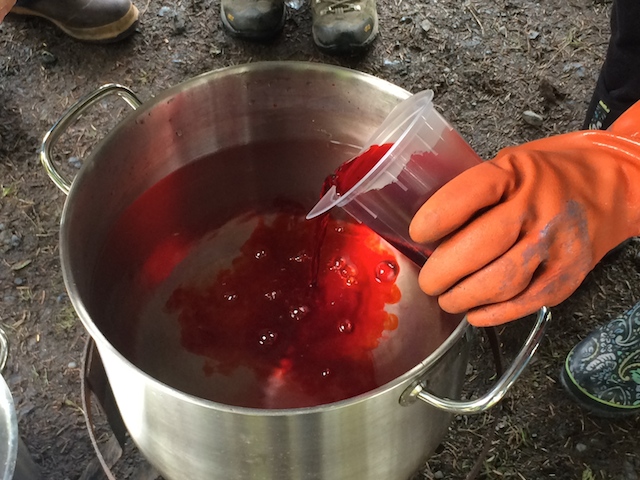
These instructions are for wool or silk. This color is trickier to achieve on cotton or linen. If available, use filtered, distilled or reverse osmosis water for the dye bath.
MATERIALS
CLICK HERE for our post on setting up your dye studio.
- Madder Extract
- A Dye Pot : Stainless Steel
- Heat Source : Stove Top, Hot Plate, Fire outside….
- Whisk
- Tongs
- Gloves
- Thermometer
- Bucket
- Your Fiber : Natural fibers like cotton , hemp , silk or wool . We have a bunch of fabric for you to work with HERE. This recipe is specifically designed for wool & silk.
PROCEDURE
- Scour fibers well and mordant with 20% aluminum sulfate and let the fibers soak in that bath overnight. Remove and extract excess water.
- Make a dye bath with 8% madder extract of your fiber and 1% calcium carbonate. This means if your fabric is 200g , you would use 16g of madder extract , add the calcium carbonate directly to the bath.
- Make sure you soak your fabric for at least one hour before entering into your dye bath. This helps open the fibers up to suck up the dye evenly.
- Immerse fibers in this dye bath and slowly bring up to temperature of 160F. Everything will look rather orange, but don’t panic. The color will develop. Rotate continually and carefully to avoid felting wool.
- The color should develop to a deep red, bordering on Burgundy. Remember colors appear about 3 shades darker when wet!
- Remove your fiber from the pot and rinse out by hand. Let it dry over night.
Different Shades
For rich reds with an orange base, omit the calcium carbonate in the dye bath.
How can I get a different red?
Madder and cochineal are the 2 historic reds that react differently when mixed with a mild acid such as cream of tartar. Madder loses its red shade and shifts to orange, and cochineal moves from a magenta shade to a bright red or pink. When using madder or cochineal, the depth of the red shade depends on 2 things: the tinctorial strength of the dye stuff, and shifting the shade with a small amount of acid. Cochineal will shift from a purple-magenta to a red or sometimes even orange shade. Madder will shift from a deep burgundy shade to orange. So the artful use of Cream of Tartar will create a different shade. Try about 1-3% on the weight of the fiber, or 1 teaspoon per pound of goods.
Cream of Tartar, also known as potassium bitartrate, is produced by fermenting grape juice. It is used to acidify the dye bath to effect a color change, and in mordanting to soften wool fibers. It will shift the color of cochineal, madder and lac from their fuchsia and burgundy red shades to a brighter, redder color.
WASH CARE
It is always best to use pH neutral soaps for your natural dyes. This means ecological brands that don’t contain optical brighteners or any sort of Once you are finished with your project you will want to wash ( in your washing machine – separate from other garments ) on a hot cycle to bleed out the excess dye. After this initial washing, it is recommended to hand wash or wash on a delicate cycle to preserve the longevity of your pieces.
